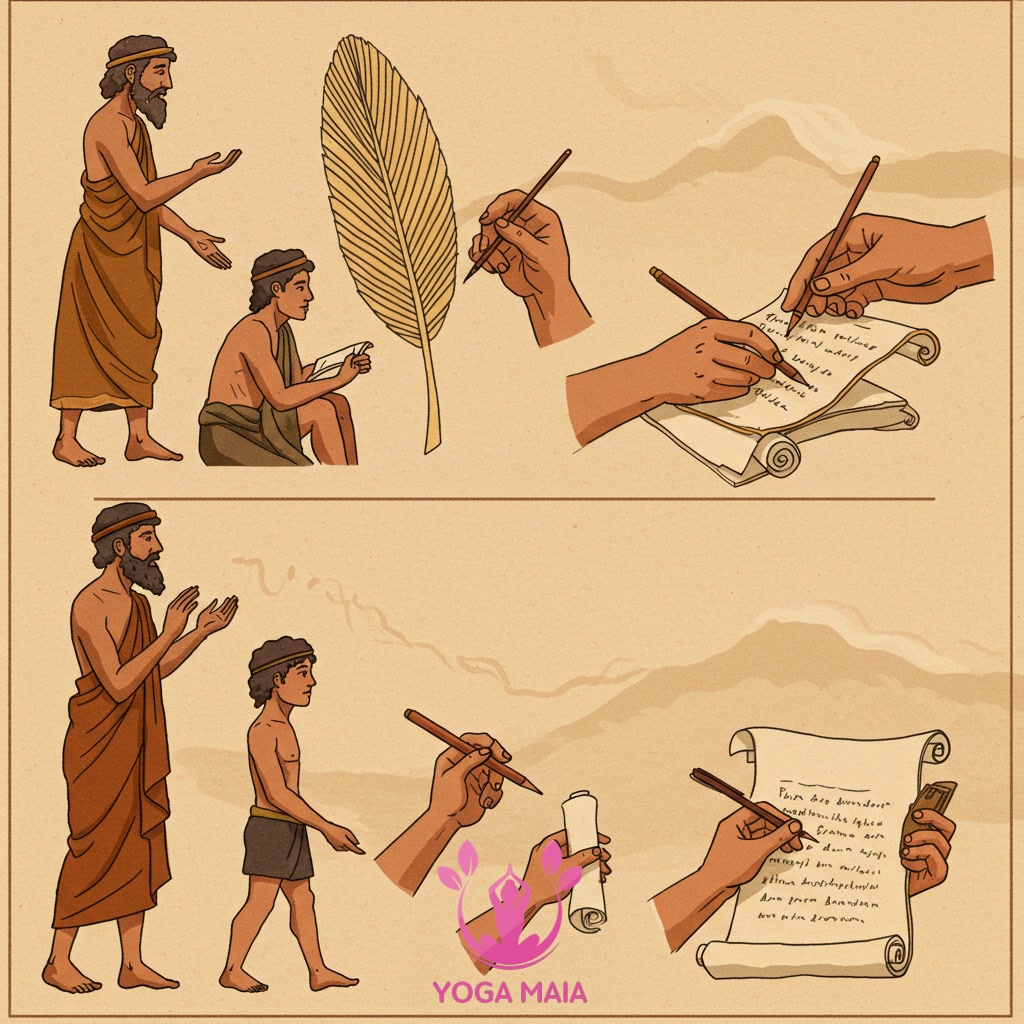Yoga Blog
Exploring Yoga’s Ancient Texts: History and Interpretations

This content explores the history and evolution of ancient texts central to understanding yoga. It examines key scriptures, discussing their historical context and the various interpretations that have emerged over time. The aim is to shed light on the foundational concepts and philosophical depth of yoga as preserved in these historical documents.
Table of Contents
- Section 1: Introduction: Defining Ancient Yoga Texts
- Section 2: Tracing the Historical Evolution of Yoga Scriptures
- Section 3: Key Ancient Texts: An Overview (e.g., Vedas, Upanishads, Bhagavad Gita, Yoga Sutras)
- Section 4: Core Concepts and Philosophies Within the Texts
- Section 5: Historical and Contemporary Interpretations of the Texts
- Section 6: The Enduring Legacy of Ancient Yoga Texts
Section 1: Introduction: Defining Ancient Yoga Texts
This document delves into the foundational scriptures that underpin the practice and philosophy of yoga. In this introductory section, we define what constitutes ‘ancient yoga texts’ for the purpose of our exploration. These are not limited to a single book but encompass a diverse collection of historical writings, ranging from philosophical treatises like the Upanishads and the Bhagavad Gita to more practice-oriented manuals such as the Yoga Sutras of Patanjali and later Hatha Yoga texts. These texts were composed over centuries, reflecting the evolution of yogic thought and practice. They serve as crucial historical records, preserving the core concepts, ethical principles, and techniques that have shaped yoga into the multifaceted discipline we know today. Understanding these texts is essential for grasping the historical depth and philosophical richness of yoga.
 Introduction: Defining Ancient Yoga Texts
Introduction: Defining Ancient Yoga Texts
Section 2: Tracing the Historical Evolution of Yoga Scriptures
Building upon our definition of ancient yoga texts, this section traces their fascinating historical journey. Initially, yoga knowledge was primarily transmitted orally from teacher to student across generations, relying on memory and disciplined recitation. The transition to written form marked a significant shift, allowing for broader preservation and dissemination. Early scriptures like the Upanishads laid philosophical groundwork, followed by the concise aphorisms of the Yoga Sutras, which systematized classical yoga practice. Later periods saw the emergence of Tantric texts and works like the Hatha Yoga Pradipika, detailing physical practices. This evolution reflects not only the development of yoga philosophy and practice itself but also changing methods of knowledge preservation and interpretation across millennia.
 Tracing the Historical Evolution of Yoga Scriptures
Tracing the Historical Evolution of Yoga Scriptures
Section 3: Key Ancient Texts: An Overview (e.g., Vedas, Upanishads, Bhagavad Gita, Yoga Sutras)
Building upon the oral transmission of yoga knowledge, its profound principles were eventually codified and preserved in a series of pivotal ancient texts. This section provides an overview of these foundational scriptures. Among the earliest are the Vedas, which contain the philosophical roots and early concepts that would later evolve into yogic thought. Following these, the Upanishads delve deeper into metaphysical ideas, introducing concepts like Brahman and Atman, crucial for understanding the spiritual goals of yoga. The Bhagavad Gita presents yoga not just as a physical practice but as a path of action, devotion, and knowledge, set within an epic narrative. Finally, the Yoga Sutras of Patanjali offer a systematic and concise framework for the practice, outlining the eight limbs of yoga (Ashtanga Yoga), providing a structured approach that became highly influential.
 Key Ancient Texts: An Overview (e.g., Vedas, Upanishads, Bhagavad Gita, Yoga Sutras)
Key Ancient Texts: An Overview (e.g., Vedas, Upanishads, Bhagavad Gita, Yoga Sutras)
Section 4: Core Concepts and Philosophies Within the Texts
Building upon the oral transmission of yoga knowledge, its profound principles were eventually codified and preserved in a series of pivotal ancient texts. This section provides an overview of these foundational documents, delving into the core concepts and philosophies that define traditional yoga practice and understanding. Within these scriptures, such as the Yoga Sutras of Patanjali and key Upanishads, we encounter fundamental ideas like the nature of consciousness (Purusha) and material reality (Prakriti) from Samkhya philosophy, the ethical guidelines (Yamas and Niyamas), the systematic path towards liberation through practices like asana, pranayama, and meditation, and the ultimate goal of Samadhi or union. These texts offer a rich tapestry of thought, explaining the intricate workings of the mind and body, the obstacles to spiritual progress, and the methods for overcoming them, forming the intellectual and philosophical bedrock of yoga.
 Core Concepts and Philosophies Within the Texts
Core Concepts and Philosophies Within the Texts
Section 5: Historical and Contemporary Interpretations of the Texts
Following the codification of yoga’s principles into ancient texts, the understanding and application of these scriptures have been far from monolithic. Historically, interpretations varied significantly depending on the specific lineage, regional traditions, and the philosophical school or guru guiding the study. Different schools emphasized distinct aspects – some focusing on physical practices (asana, pranayama), others on devotional paths (bhakti), or intellectual understanding (jnana). In contemporary times, interpretations continue to evolve, influenced by modern psychology, scientific understandings of the mind and body, and the integration of yoga into diverse global contexts. Modern scholars and practitioners engage with these texts through new lenses, sometimes synthesizing traditional views with contemporary perspectives, highlighting the dynamic and living nature of these ancient teachings. This ongoing process of interpretation ensures the relevance and adaptability of yoga’s foundational wisdom across generations.
 Historical and Contemporary Interpretations of the Texts
Historical and Contemporary Interpretations of the Texts
Section 6: The Enduring Legacy of Ancient Yoga Texts
Following the recognition that interpretations of ancient yoga texts have varied significantly across history and traditions, this section explores the profound and enduring legacy these scriptures hold today. Despite differing schools of thought and evolving practices, core texts like the Yoga Sutras, Bhagavad Gita, and principal Upanishads remain foundational touchstones. Their concepts on ethics (Yamas, Niyamas), physical postures (Asana), breath control (Pranayama), meditation, and the nature of consciousness continue to inform contemporary yoga practice and philosophy worldwide. The adaptability of these ancient teachings, allowing for diverse applications from physical fitness to deep spiritual inquiry, is key to their longevity. Their enduring power lies not just in historical preservation, but in their continued relevance and capacity to guide practitioners on a path of self-discovery and transformation in the modern era.
 The Enduring Legacy of Ancient Yoga Texts
The Enduring Legacy of Ancient Yoga Texts












